| |
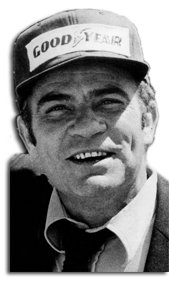
1930-1968
GUY LIGIER, SPORTSMANSHIP
The passion for sport
Guy was born on July the 12th of 1930 in the town of Vichy.
Orphaned at the age of 7, he builds himself a fighter character. At 14, he becomes a butcher learner in his hometown.
Inveterate sportsman, he has a passion for rowing and he becomes champion of France in 1947.
 1947 : Guy LIGIER, champion of France in rowing with PLANCHE and CHASSELUT 1947 : Guy LIGIER, champion of France in rowing with PLANCHE and CHASSELUT
Meanwhile, he makes a career as a rugby player in 50’s and measured at the best French hooker. |
|
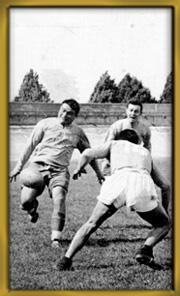 |
|
|
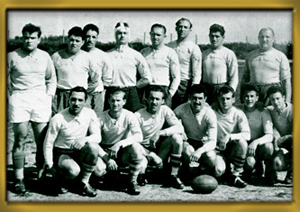
Hooker of the RC Vichy |
|
| |
Rugbyman in action |
Beginning as pilot
Passionate for motor sport, he starts his career as a pilot at the handlebars of a motorcycle, a 500 Norton and win the French title in 1959 and 1960.
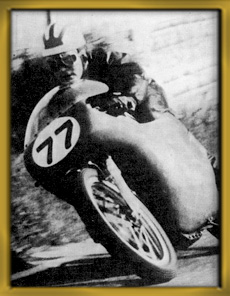 |
|
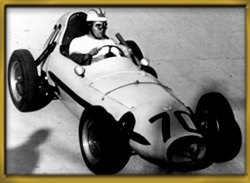
At the steering wheel of a Elva D10 |
|
He then buys an Elva DKW Formula Junior in 1960 and will enrol himself... in Monaco GP!
He will miss his qualifications, but here is the beginning of a beautiful story on four wheels. |
| On his Norton 500 |
The same year between 2 races, he rent a backhoe for work, which allows him to run on a motorcycle races. Then he invests in and buy his first machine of public works. He later found his own public works company: Ligier Civil Engineering, helped by Pierre COULON, Vichy’s Mayor.
In 1961, he manages a company with 1,200 workers and 500 machines.
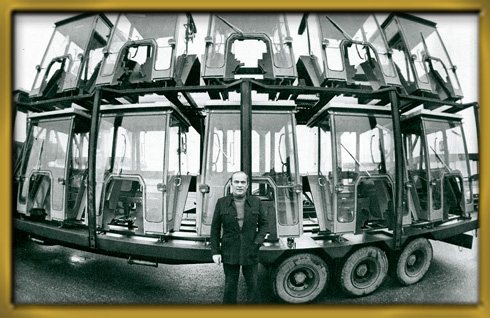 Tractors made in Ligier Tractors made in Ligier
When creating the new Formula 2 1000cc engine in 1964, Ford France is a team of two cars Brabham BT6. These two models, with a Cosworth SCA 1000, are the ones of the previous year. One of the two BT6 will be replaced during the season by a new Brabahm BT10.
Both pilots are Jo SCHLESSER and Guy LIGIER.
So at the age of 34 he starts a "real" career as a pilot.
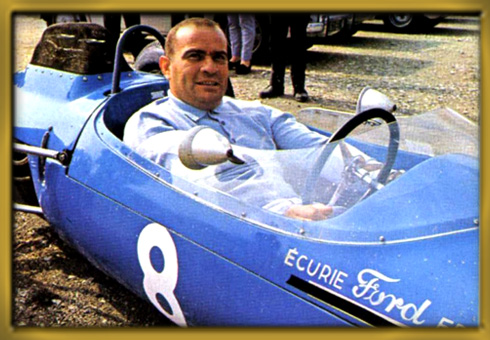 Guy LIGIER at the steering wheel of the Brabham BT10, in 1964 Guy LIGIER at the steering wheel of the Brabham BT10, in 1964
1964 : he is back in rallies and at the 24H of Le Mans driving a Porsche 904. He becomes friend with Jo SCHLESSER in 1965. Animated by the same passions, they become loyal friends ... inseparable as brothers !
Meeting with Jo SCHLESSER « my friend »
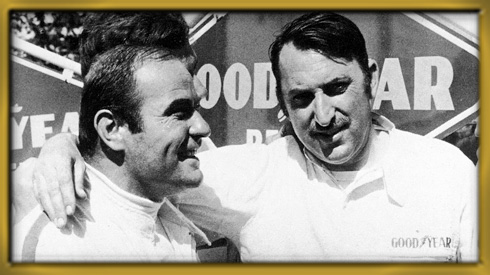 Guy and Jo at Nürburgring in 1966 Guy and Jo at Nürburgring in 1966
1965 : Jo introduces Guy to the Ford France Team, where they are both pilots.
Well integrated into the team, he lets himself be persuaded by Henri CHEMIN (public relations manager for Ford France Team) to buy his own Ford GT 40 just before |
|
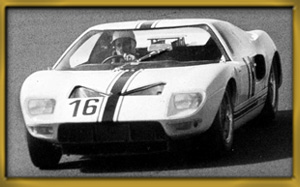 At the steering wheel oh his Ford GT40 in 1965 At the steering wheel oh his Ford GT40 in 1965 |
|
| the 1000 km of Nürburgring in which he will participate. Support and commitment are managed by the Ford France Team. |
Now team-mates, they do endurance with a Ford GT40 then on a 7-liter MK II and with the F2 Brabham. Meanwhile, Guy gets a budget of BP allowing him to start in F1 in 1966 and will be the only French in the Championship.
French champion in proto-sports that year, his beginnings in F1 are laborious and his capricious Cooper-Maserati drives him off the road during the tests at the Germany GP.
Without the intervention of his friend Jo SCHLESSER, who organizes
|
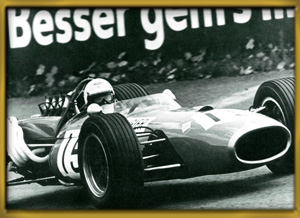 1966, Brabham Repco 1966, Brabham Repco |
|
his repatriation in France in a good hospital, Guy would have been amputated of a leg! Healed, he will take a brilliant revenge hanging up the 6th place of the GP of Germany in 1967 on his Brabham-Repco, and triumphs with Jo in the 12 Hours of Reims.
That year, he win 5 GP and 7 in 1967. |
|
|
|
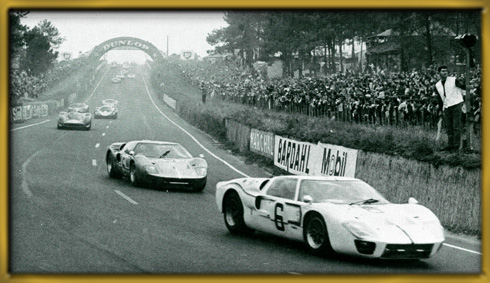 24h of Le Mans 1967, Ford MKII of LIGIER-SCHLESSER 24h of Le Mans 1967, Ford MKII of LIGIER-SCHLESSER |
1969-1976
LIGIER MANUFACTURER
Creation of the Team Intersport
Ford France stopping its activities, the two friends decide to found the Intersport Team with José BEHRA (brother of John) in 1968 aligning McLaren in Formula 2. A bad choice, the cars often brittle. During the season, Jo, tired of chasing after the good steering wheels Jo launch the idea "if we had our own cars?". The question will remain unanswered. Jo Schlesser is killed on July the 7th of 1968 during the French GP in Rouen on a Honda official. It was his first race in F1 ... Hearing the new on the radio, Guy is devastated. He just loose his faithful friend. Following to this announcement, he decides to retire at the end of the season.
In memory of Jo, the cars will be named JS.
Beginning of a long JS line
In 1969, steel animated by this desire to make racing cars, Guy launch himself alone on the adventure.
The same year he presents the JS1 during the 50th Car Show in Paris. For the competition, JS1 receives a Ford Cosworth engine. |
|
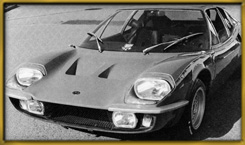
The first JS1 |
Its bodywork is designed by Frua on the instructions of Guy Ligier lightness, compactness and especially visibility. Hence this huge down windshield. Three copies of the JS1 are built, initially equipped with Corsworth VCF 1790 cm3, and for the Tour Auto in 1970 with the 2.6 l V6 Ford Capri. If these few cars give up, Guy Ligier gets some success on tracks with its JS1 in Albi or Magny-Cours.
Between 1969 and 1975, 130 Ligier (with different models) will be manufactured.
1970, he returnes to competition on the 24 hours of Le Mans on the JS1 and with Jean Claude Andruet as team-mate.
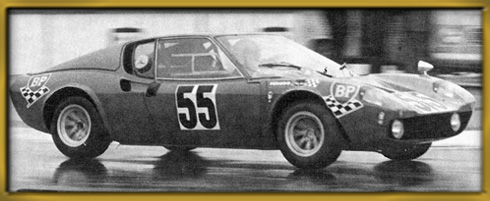 JS1 testing in the 24h of Le Mans in 1970 JS1 testing in the 24h of Le Mans in 1970
Too sporty for customers and too wise to "win" this model doesn’t really work soon. Moreover, Guy will notice later that it can not produce it in series. With the JS2 a smart GT, he really becomes manufacturer in 1971. |
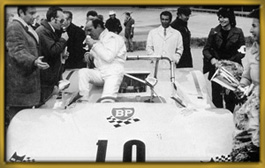 Victory in Montlery on the JS3 in 1971 Victory in Montlery on the JS3 in 1971 |
|
The same year, he creates "Ligier Automobiles: design and production of competitive vehicles and build a “Barquette” F1 V8 Cosworth JS3 designed by Michel Tetu.
It carries the colors of BP and Guy is the pilot.
With it, he win the Spring Cup in Montlhéry and finish
|
second at the 4 Hours of Le Mans.
For a while in the 24 Hours of Le Mans, Patrick Depailler Guy Ligier reaches the 5th position before downgrade following numerous mechanical problems.
Supported by the public, the small team manage to finish the race but not classified.
|
|
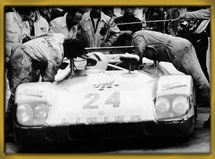
The JS3 of LIGIER and DEPAILLER
at the 24h of Le Mans in 1971 |
In 1972 and 1973, the JS2 is engaged in competition without success. But the takeover of the rafters by Peugeot, followed by the sale of Maserati to De Tomaso, sounds the death knell for the JS2. Without engine, Ligier is at its worst, particularly as the civil engineering firm just fall for bankruptcy. Nevertheless Guy still fights. A total of ten JS2 will be committed to Le Mans from 1971 to 1975, with an excellent 2nd place in 1975 gets by Guy Chasseuil and Jean-Louis Lafosse.
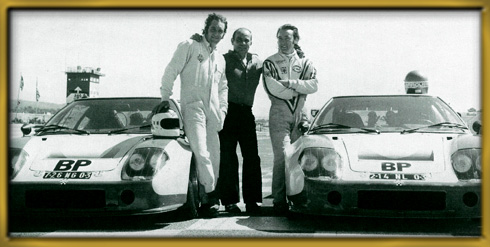
Tour Auto 1972 on the Paul Ricard circuit, Guy CHASSEUIL, Guy LIGIER and Gérard LARROUSSE
The JS2 with Maserati engine win the victory in the Tour Auto (Larrousse / Nicolas) 1974.
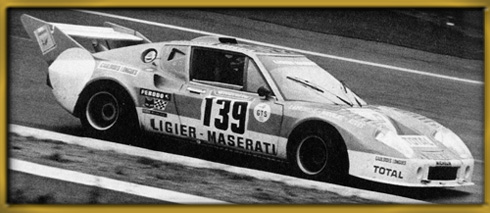 Photo victory at the Tour of France JS2 Larousse/Nicolas N°17 Photo victory at the Tour of France JS2 Larousse/Nicolas N°17
That year Matra stop the competition! It sponsor SEITA seeks for another team to show the colors of Gitanes. Like the Phoenix rising up from its ashes, the creation of a F1 for the season 1976 is announced! Meanwhile, the team works on the JS2 with a Cosworth engine on endurance races and bring a 2nd place in the 24 Hours of Le Mans in 1975 with Jacky Ickx and Derek Bell.
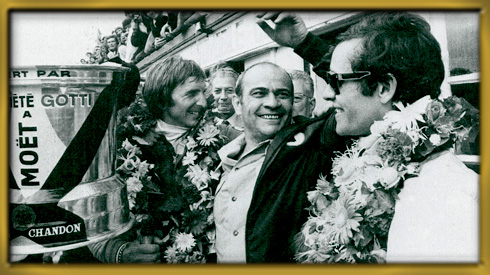 Podium of the 24h of Le Mans, Guy LIGIER between Dereck BELL and Jacky ICKX Podium of the 24h of Le Mans, Guy LIGIER between Dereck BELL and Jacky ICKX
The Ligier team continues to grow by becoming the assembler for Citroën SM Maserati, and then in 1976, a new step is taken with the birth of the Formula 1 team.
1976-1992
LIGIER AND FORMULA 1
JS5, Birth of the first F1 Ligier
In 1975, the idea of a Formula 1 is launched. The studies start in March 1975.
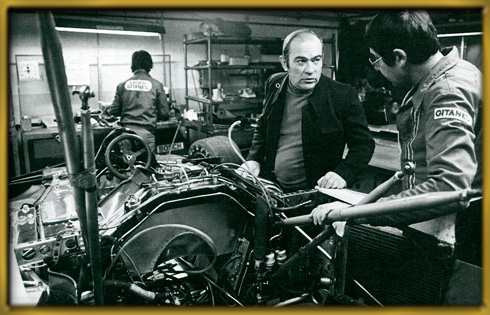 In the secret oh the F1 in Abrest In the secret oh the F1 in Abrest
The aim is to build a car at the best. To do so there is only one team who gets great experience: MATRA who just yet leave the tracks.
With MATRA engine, this will be a 100% French car.
The men of the construction of the JS5:
| • |
Michel Beaujon : Strength material calculation specialist |
|
| • |
Paul Carillo: designer of the JS5 from A to Z. |
|
| • |
Gérard Decarouge: main actor of the Ligier organization. He is study and marketing director of the JS5. He also participates in its development and construction. |
| |
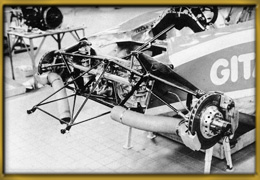 |
|
|
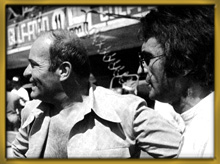
Guy LIGIER and Gérard DECAROUGE |
| < Tubular frame of the JS5 |
|
The beginnings of the great epic time
On October the 27th of 1975 the first F1 Ligier receives its latest controls and run in November of that year on the track of “Mas du Clos” with Guy driving.
Then in 1976 Ligier appears in F1 and Guy enrol his own brand supported by SEITA and the manufacturer Matra. Jean-Pierre Beltoise drive for the first tests and the basic settings but it is Jacques Laffite who is finally chosen as a pilot. On January the 13th, it is the ultimate tests of the JS5 who wear the N° 26 for the first time and with J. Laffite driving.

JS5 at the time of the first fights the F1
The first results are more than promising as the team win several podiums in 1976. 1977, the young team is struggling to confirm the results of the last year and continues the performances until Sweden GP, where Laffite take the departure of the race anonymously on the JS7 and win the first victory at the end of an unexpected rise on June the 19th.
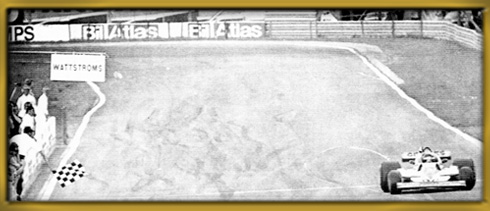
LAFFITE, glory in Sueden
In December, Jean-Luc Lagardère, CEO of Matra, says he would leave from the competition in 1978 which means to find other types of engines. This will be Ford-Cosworth engines.
Great Years Ligier
1978 Ligier wishes to align a second car in the 1979 championship. At Monza the good news is announced: SEITA will increase the budget for the second car. The arrival of Patrick Depailler in the Ligier-Gitanes Team is also announced.
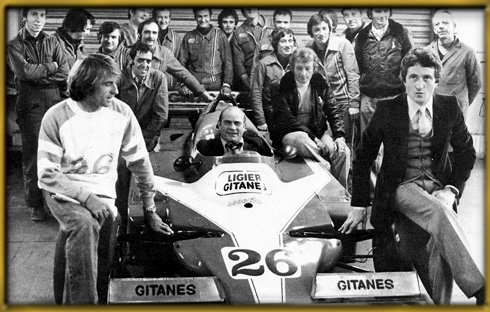
In front, J. LAFFITE, G. LIGIER and P. DEPAILLER in Abrest
1978-1979 the JS11 appears, a "wing car" designed by the engineer Gérard Decarouge. It will be the most reproduced car in early 1979. Thanks to an excellent quality steel-frame and a great duo, Ligier win three of the five first rounds of the season.
On January the 21st of 1979, Laffite win the Grand Prix of Buenos Aires in Argentina with the JS11 who makes a "masterstroke for his first run" Depailler is 4th.
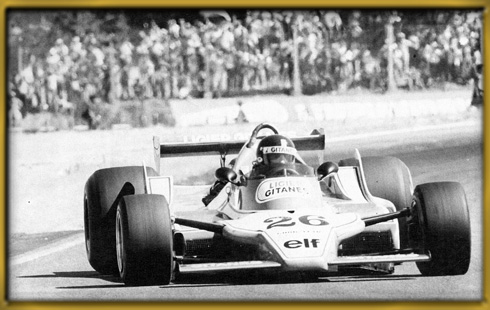
GP of Buenos Aires, JS11 Interlagos
On February the 4th of 1979, both cars of Depailler and Laffite are aligned on the front line at the Grand Prix of Brazil and make the performance: first Franco-French doubled in the history of F1. |
|
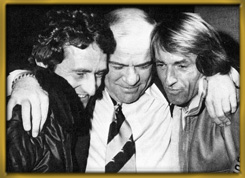 |
Trio of winners ,
P. DEPAILLER, G. LIGIER and J. LAFFITE > |
|
|

On TV in Sport 1st : Denise LIGIER, Christian QUIDET, Guy LIGIER and Michel DENISOT |

The 2 Ligier F1
|
|
But Depailler is hurt in a hang glider accident shortly before the mid-season. Combined with limited budgetary resources, this greatly disrupts the development of the JS11, dominating early in the season but inexorably overwhelmed by the Ferrari and Williams over the years.
In 1980, the Ligier team constitute with the duo Laffite-Pironi, confirms its status of fine form with two wins and a constant presence in the front positions. That year, the team is second at the world manufacturer’s championship. |
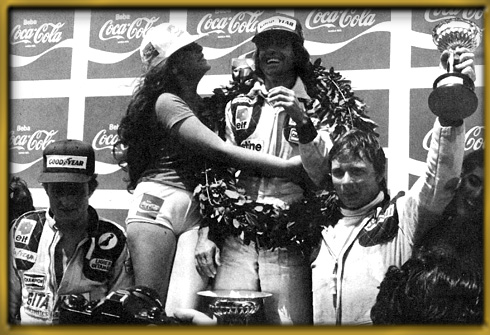
LAFFITE, DEPAILLER and PIRONI on the podium |
Along with its involvement in motorsport, the brand, Ligier begin designing cars. In the Alvesta factory it was the birth of the car without a license.
In 1981, when the team benefits from the involvement of the Peugeot group (via Talbot-Matra), Ligier do a very early average season, but the results take off at the end of spring. Laffite get places of honor and win two victories which will put him back to the fight against the world title. On the eve of the last GP of the season in Las Vegas, he is 3rd in the championship with a real chance to be titled but the miracle does not happen. Laffite will only reach the 4th place of the general classification. |
He is overtaken by his team-mate, the American Eddie Cheever who finishes on the podium 3 times, including a second place in Detroit. The 1983 season will be very bad.
|
|
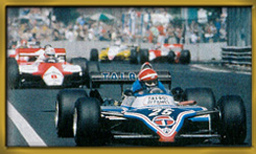 |
| Eddie CHEEVER > |
On the down slope
The 1981 season mark the end of the golden age of Ligier. In 1982, while the performance of the French team is in free fall, Peugeot withdraw and makes Ligier loosing the hope to benefit from an exclusive short-term turbo engine, sesame necessary to shine in F1 in 80’s. |
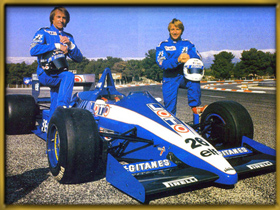
LAFFITE and ARNOUX beside the JS27 |
|
From 84, the team finally enjoys a Renault V6 turbo engine but will only use it in 1986 when Laffite and Arnoux are highlighted several times. The return to good form of the Ligier team takes end in mid-season with a serious accident of Laffite at the start of the GP of Great Britain. |
End of 1986, Renault leaves the F1 but Ligier thought to have found an attractive alternative with Alfa Romeo. Unfortunately, the acquisition of Alfa Romeo by Fiat changes the situation. Alfa Romeo Ligier abandons a few days before the start of the season 1987. This is the beginning of a tumultuous period in which motorists, pilots and engineers succeed for another in variable and disappointing performances.
The Ligier team is dropped to the bottom of the ranking, with one point picked up by René Arnoux, then none in 1988 and 3 in 1989. The two following seasons of the blue cars will finish with a blank score.
1992 - 1997
From hand to hand
New owners
At the end of the season 1992, when Comas and Boutsen give 6 points to the team, Guy Ligier abandon the direction and sold the majority of shares of the team to the contractor Cyril DE ROUVRE (already in F1 as owner of the team AGS). Meanwhile, Ligier is world champion of electrical cars in series.
With its new owner the team seems to find a new life in 1993 and mark a return to form of the "blue car" ending at the 5th place in the constructors championship thanks to the British drivers Brundle and Blundell, finishing 3rd three times . But the involvement of DE ROUVRE only last one season because of legal trouble.
In 1993, Flavio Briatore buys the shares and become the only shareholder in 1994. He wants to install a Scottish to the head of Ligier, Tom Walkinshaw, who plan to move to England. Following the outcry, the Scottish resigns. In poor financial position and with no potential buyer, the fate of the Ligier team appears dark, except at the Germany GP, the Ligier of Panis and Bernard end 2nd and 3rd of the race. Note that at the start, ten cars are disqualified after two piles up. |
| The following season, Brundle finishes 3rd in Belgium, while Panis finishes second in Australia. Guy Ligier decides to devote himself to the development of its cars without a license. |
|
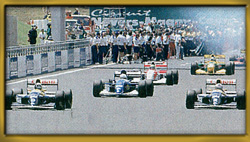
GP of France 1993, 2 Ligier on the 2nd line |
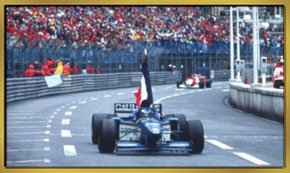 Olivier PANIS victory on the JS41 Olivier PANIS victory on the JS41 |
|
On May the 19th of 1996 it is a final triumph for the F1 team with Olivier Panis who win the prestigious Grand Prix of Monaco on the JS41. This event will boost the media interest around the brand.
|
Redemption and liquidation
In 1997, Guy Ligier decides to sell the team to the four world champion Alain Prost, but the Prost GP adventure will end in 2002 after 5 seasons.
1997-2009
Development of lines of vehicles without a license and return to motor sport.
Cars without a license, a growing market
After the sale of his team, in its factory, the market for cars without a license is well underway. More than 50 cars goes out every day of the production plant. |
In 2000 it was the creation of a "Fun" Ligier sport with its first product "Be Down", which is labeled in 2001 by the Center Georges Pompidou.
In 2002, Ligier Automobiles presents a concept car « Be Run » at the World Car Meeting. |
|
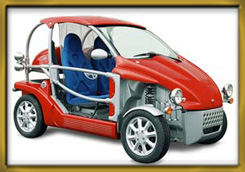
The Ligier "Be-Up" |
In 2003, the Ligier cars with no licence represent 23% of the share market with 6000 vehicles produced. It is already 6 years of growth and over 10 000 registrations a year. The launch of the Ligier X-Too is held at World Car in 2004.
2004: Approximation Ligier-Martini
Beginning in 2004, Guy Ligier takes meaningful participation in Automobiles Martini society, ending with a formal association with Tico Martini. He says: "I want to finish my life happy in what I like".
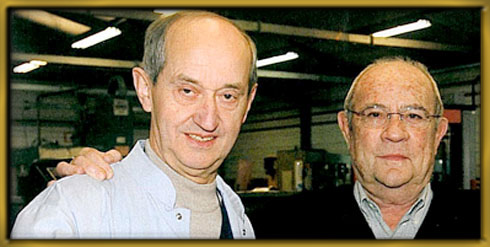
Guy and Tico
Thus the two entities, blazons of French motorsport, decide to make common cause. Their first "baby" is a Ligier MK 84, a competition car bound to motor sport and driving initiation, is presented to the public at the World Car Meeting in 2004. Then the JS 47 is reserved for Formula 3 Championship since the season 2005.
From the Ligier Automobiles side, demand increase which results in the launch of new products line of utility cars, quad...
The figures in 2006:
- 150 employees,
- 7200 vehicles manufactured,
- 15,000 sqm factory with 5000 sqm of expansion in 2007,
- Assembly line up to 60 vehicles per day.
2006 is the launch of the sports prototype 49 Ligier which is good for circuits, coast, drive schools, incentives. It combines performance and driving pleasure. This 535kg car, fitted with a Honda engine and drive by Jonathan Cochet, run for the first time on October the 28th of 2005 at the 4 000 km of Nevers-Magny-Cours.
Source :
Michel BONTE, François HUREL, Jean Luc RIBEMON
Le Mans, un siècle de passion avec L’ACO – Editions Publi-Inter 2006
Jean Pierre GOSSELIN, Renaud DE LABORDERIE,
préface Pierre MAZEAUD
GUY LIGIER – Editions Solar 1976
Jean Pierre GOSSELIN, Renaud DE LABORDERIE,
préface Stéphane COLLARO
GUY LIGIER – Editions Solar 1979
Source Internet :
www.autodiva.fr
www.statsf1.com
http://fr.wikipedia.org
http://ligier.chez-alice.fr
www.histomobile.com
|
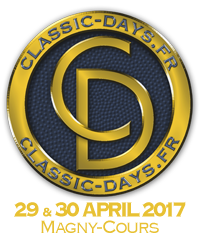


 1947 : Guy LIGIER, champion of France in rowing with PLANCHE and CHASSELUT
1947 : Guy LIGIER, champion of France in rowing with PLANCHE and CHASSELUT



 Tractors made in Ligier
Tractors made in Ligier  Guy LIGIER at the steering wheel of the Brabham BT10, in 1964
Guy LIGIER at the steering wheel of the Brabham BT10, in 1964  Guy and Jo at Nürburgring in 1966
Guy and Jo at Nürburgring in 1966



 JS1 testing in the 24h of Le Mans in 1970
JS1 testing in the 24h of Le Mans in 1970


 Photo victory at the Tour of France JS2 Larousse/Nicolas N°17
Photo victory at the Tour of France JS2 Larousse/Nicolas N°17 Podium of the 24h of Le Mans, Guy LIGIER between Dereck BELL and Jacky ICKX
Podium of the 24h of Le Mans, Guy LIGIER between Dereck BELL and Jacky ICKX In the secret oh the F1 in Abrest
In the secret oh the F1 in Abrest












 Olivier PANIS victory on the JS41
Olivier PANIS victory on the JS41 
